VidiGug
Pronounced:.Veejy-Googy
A.Guggenheim.Museum.for.the.Vidigal.Shantytown.in.Rio.de.Janeiro
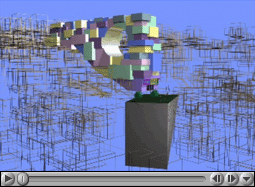 |
|
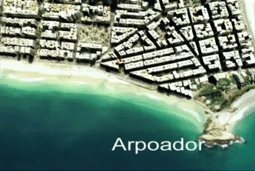 The new 3-D animation begins with a fly-over of Arpoador beach..... |
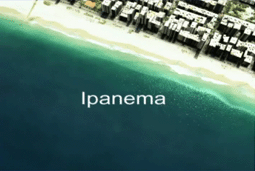 x . |
 o Leblon.. . |
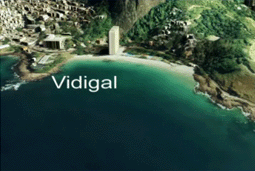 until arriving at the Vidigal Shantytown... . |
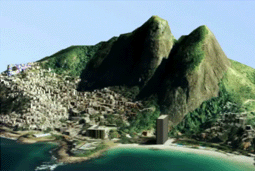 on the Two Brothers Mountains... . |
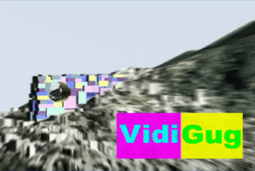 and closing in on the VidiGug. . |
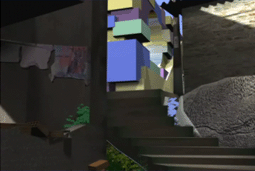 After a walk-up through the favela... . |
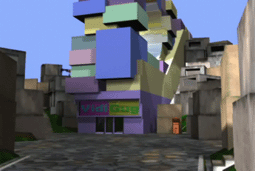 the museum appears. . |
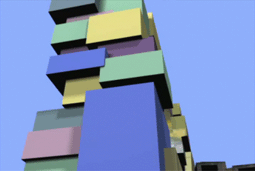 x . |
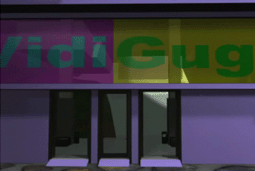 The entrance. . |
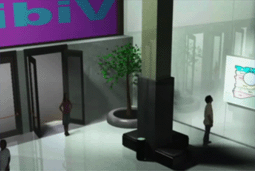 The lobby. . |
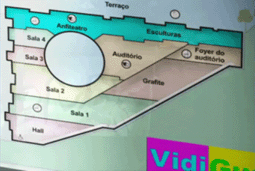 An elevation of the museum. . |
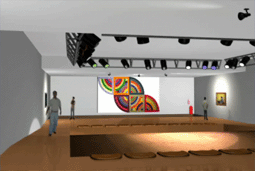 The uppermost exhibit space contains a unique amphitheater.... |
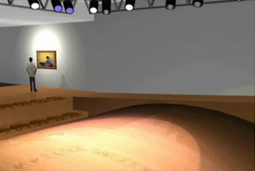 with a bevelled stage that takes advantage of... |
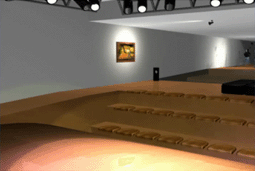 the top of the hole in the museum... . |
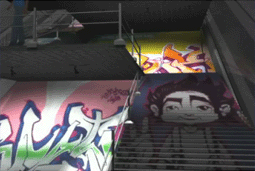 The Losango Room is a giant parallelogram space dedicated to the art of graffiti.... |
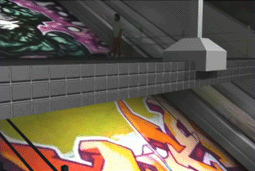 with various observation platforms. . |
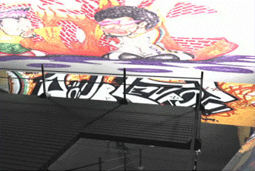 x . |
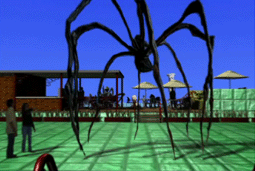 On the roof is a sculpture garden and café.. |
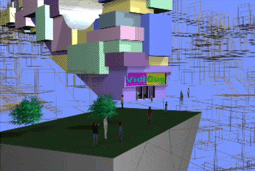 This sequence shows the building to which people living in the location of the VidiGug... |
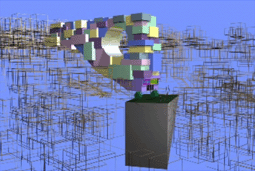 would be relocated. Note how the rooftop of the relocation building serves as a plaza... |
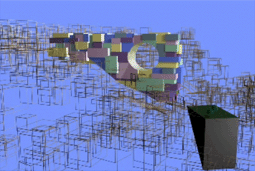 in front of the museum creating much needed public space for the community.. |
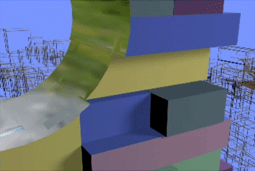 The interior of the hole is mirrored... . |
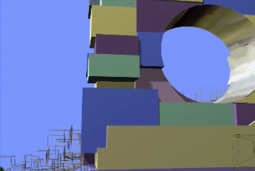 allowing for views outward from within the various room flanking the hole. |
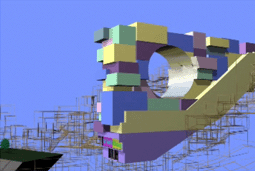 x . |
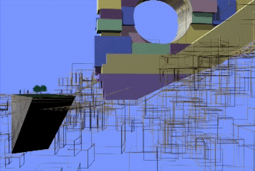 x . |
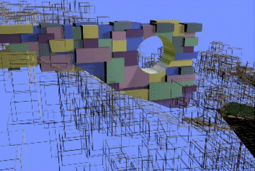 x . |
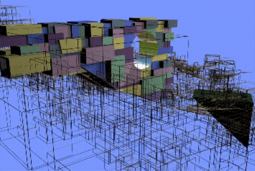 x . |
 Special thanks to K2 Sistemas in Rio for generously contributing the 3-D modelling and rendering of the VidiGug.. |
(((.please.send.your.comments.
to.yo@rickyseabra.com.))) |
To
follow are the first drawings and texts of the VidiGug:
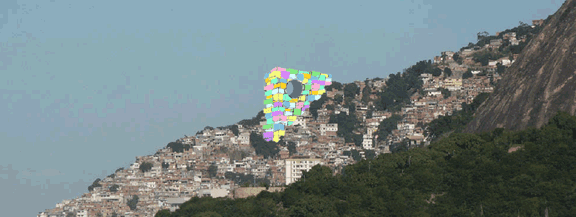
|
From 2001 to 2003 the mayor of the city of Rio de Janeiro Cesar Maia attempted to push for the construction of a Guggenheim Museum in Downtown Rio on a pier extending off the Praça Mauá waterfront. The design by Jean Nouvel (architect of the Institut du Monde Arab in Paris) would be priced at 200 million dollars. Rio would supply the money. The Guggenheim, its name and works of art. The project was embargoed and shelved. Nonetheless, the idea of the extension of the Guggenheim franchise to Rio de Janeiro did capture the Carioca's imagination. So one day... on the beach of Ipanema I looked towards the Vidigal shantytown (favela) on the Two Brothers Mountains and had an idea. I thought that the vision of a Guggenheim in Downtown Rio wasn't as thrilling as the Bilbao project.
For a Guggenheim to be as audacious and innovative as the Bilbao project it either had to be built in a completely out-of-the-way-gem-of-a-city like Santo Amaro da Purificação (Bahia) or ...here it goes... at the top of one of Rio's most notorious favelas; the Vidigal. The museum's name; The VidiGug. And the only way to get to the VidiGug would be by foot through the favela. Critique of the Downtown Rio Guggenheim Proposal: Juan Ignacio Vidarte, Director of the Guggenheim Museum Bilbao and project director of the feasibility study for the new Guggenheim in Downtown Rio said, "As in Bilbao, the new Guggenheim Museum in Rio will anchor a major urban redevelopment program and is certain to have a positive impact on the region." I agree with Mr. Vidarte that it would have a positive effect on the Praça Mauá waterfront side of Downtown Rio. But I wouldn't be surprised if it would cause the demise of the opposite waterfront where a large Museum of Modern Art already exists (the MAM). Plus, Rio already has its Frank Ghery equivalent of a museum: Oscar Niemeyer's Museum of Contemporary Art (below) in Niteroi; a museum that has led (like the Bilbao model) to the revitalization of Niteroi's waterfront with a series of Niemeyer buildings currently under construction. So Rio doesn't really need another piece like that.
The Praça Mauá area to be revitalized is small compared to the historic center that is always mentioned in the Downtown Rio Guggenheim Proposal. In addition, Downtown Rio is doing quite fine, thank you. Hang out there at happy hour on any business day (especially Thursday and Friday) and you'll see that the city center is among the most vibrant and happening city centers you'll ever visit. If Rio needs any major urban redevelopment program it is in the favelas. To bring in a powerful name like Guggenheim to spearhead the redevelopment of one of Rio's favelas would be far more audacious than another museum downtown. Not only would it serve as an inoculation of change that could affect the rest of the favela it could inspire other models of cross cultural cooperation in other favelas throughout the country; the transformative power of art put into practice on a grand scale. This approach would MATCH the audacity of the Bilbao model... not IMITATE it as a waterfront development concept . I feel that the idea of a VidiGug is as wacky, innovative and daring as the titanium curves of Ghery.
OK... let's get real now... Indeed, it could all fail with just one attack on the Guggenheim collection from drug lords on one hot Rio night. I'm not saying this would be an easy project. Nor am I saying that it is a feasible project. But when I bring up the idea here in Rio (usually in bars) it causes a lot of positive nods of the head and discussion... discussions about community and municipal government dialogue - something that seemed to lack in the Downtown Rio proposal. The idea of a Guggenheim in a favela evokes many scenarios of success and failure. And this is what is so exciting about the VidiGug vision; the amount of discussion and potential for transformation that a project like this will generate. The VidiGug would be more than just a museum or a project for urban renewal. It would serve as a catalyst for urban integration. I mean asphalt/favela integration (by asphalt I mean the "normal" city in which citizenship, law and order are part of the urban fabric). Favelas, however, are crowded urban islands. Their very structure of narrow and steep dangerous pathways does not allow law, order and a sense of citizenship to reach the thousands of families that reside within them. And quite often outsiders need permission from drug lords in order to enter a favela. In Rio there is a dramatic economic and racial divide between asphalt and favela dwellers. The integration of the two has been the concern of programs like Favela Bairro (Favela Neighborhood), an urban program that intervenes in favelas by building stairways, paving sidewalks, introducing lifts, garbage disposal and sewage systems into the favela; an attempt at bringing some semblance of dignified living standards to favela dwellers. Various successful projects have been carried out in favelas so the idea of architectural or even cultural intervention in the favela is nothing new. However, the difference with VidiGug is that 1. it would be extremely high profile and 2. it would bring integration in the OPPOSITE direction (asphalt > favela) by injecting the tourist and asphalt dweller INTO the favela. Is the Museum the exhibit? Are the favela-dwellers the exhibit? Or is CHANGE the exhibit? YES is probably the answer to all three questions. Hopefully a curatorial program would be put into place in which the favela-dweller will be visitor AND participant. But with tourists visiting this museum, the favelas architecture and its dwellers will inevitably be put on display. I imagine some degree of social assistance will be needed to help the community rise to the opportunity of offering a safe and interesting environment to their visitors. A project like this can foster community responsibility from the day negotiations start to take place. It will be interesting to see how the favela commerce develops in the face of "asphalteers" moving inward (a movement that not even the Favela Bairro projects predicts). Of course, the pathway that leads straight to the Guggenheim will become very "touristy" (like Damrak/Amsterdam, Ramblas/Barcelona, Times Square/New York). However, there will always be the tourists who will venture off the main tourist routes exploring the "Off Broadways", the alternative scenes. It would be a wonderful thing if indeed a favela could evolve to this point of accommodating these gradations of tourism and commerce beyond the perimeters of the pathway to the VidiGug and the Museum itself. |
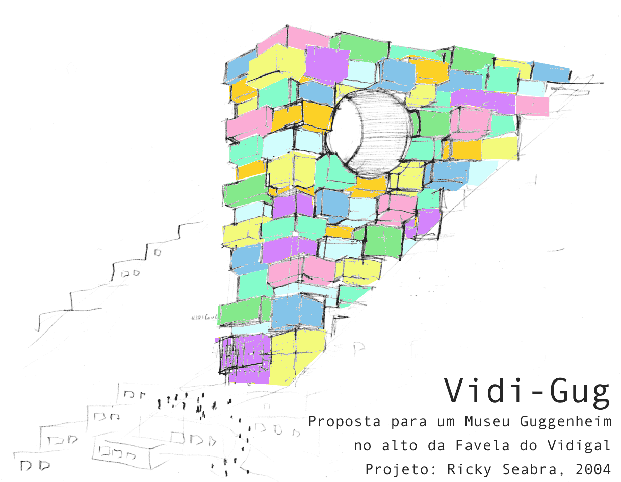
Sketch
of museum exterior
|
Aesthetics The VidiGug need not be a huge building... just one that Rio can afford with perhaps matching funds from international partners. The oeuvre plastique, the building itself, consists of a bunch of blocks placed on top of each other in a chaotic fashion reflecting the disorderly growth of the favela itself. The colors would be based on the Pelourinho in Salvador, Bahia. Here I want criticize the idea (that so many people have here in Brazil) that if only favelas were to be painted that they would look so much nicer (as if that would solve the favela's social problems and domination by drug lords). But it's not just about social critique... There is a component of the Brazilian psyche which, I believe, places Salvador's Pelourinho on the pedestal of the Brazilian imagination. Whenever a favela is portrayed in Brazilian naïf painting, for example, in almost 100% of the cases, all the huts are painted in different colors resembling this Pelourinho color scheme when in fact favelas are concrete or brick colored at best. I believe a sort of collective color memory is at play here - one that dates back to colonial Brazil or even further back to Lisbon's Alfama.
The Vidigal Guggenheim is perforated with a giant whole allowing for a spectacular circular frame view of Ipanema, Rio and Niteroi from within the auditorium space.
|
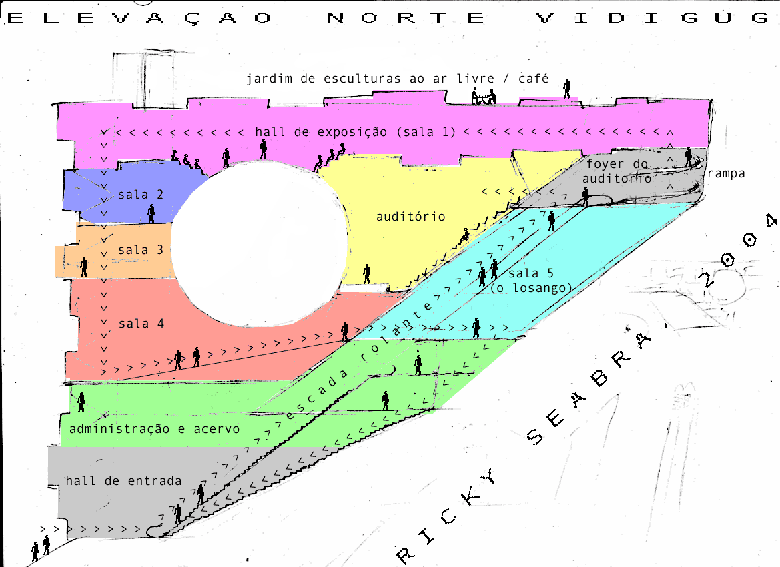
Sketch of Northern Elevation of the VidiGug
|
Inside the VidiGug The building is located on a 45 degree slope and is roughly 12 stories high in the front and two stories high in the back. The building, however, contains 7 levels. The design includes an entrance hall (in gray on the lower left hand side in diagram above). A long escalator sends the visitor from the entrance hall straight up to the foyer of the auditorium. Behind the stage is a large convex glass wall giving the spectator a rare view of Rio. This glass wall could be covered for performances. Rising up a ramp from the auditorium foyer the visitor encounters the first exhibit hall. A long multi-faceted multi-leveled space which reflects the chaotic exterior surface of the buildings exterior. This space as well as all spaces would contain ramps for the disabled. The visitor can opt to go to the observation deck/outdoor café/sculpture garden on top of the building. This large exhibit hall also contains a bizarre beveled sunken stage area that takes advantage of the top of the large whole within the building. This stage can be adapted to be a normal flat surface depending on exhibit demands. Then the descent into the building begins: first through two small installation rooms (Sala 2 & 3 in diagram above) then to the room underneath the whole (Sala 4). The visitor then walks up a ramp leading to a large trapezoidal space (Sala 5, O Lozango). The visitor then descends along a wide stairway/plaza containing internet and audiovisual terminals with headphones for viewing videos of documentaries, films, performance art, etc from the video archive. Finally the visitor would continue down the steps out the building into a small plaza in front of the building. (After computer renderings of the VidiGug are complete I will add square footage to each room to this description). A vision for gradual change. Rio-based architect Jorge Mario Jáuregui describes 4 types of Urbanisms or interventions in favelas used in the past: Defensive Urbanism (employed to safeguard architectural and natural monuments); Requalifying Urbanism (with emphasis on recomposing physical form); Strategic Urbanism (one that limits interventions to small key areas that would influence and result in broader changes); and an Urbanism of Socio-Urban Articulation (which seeks to "knit" the city together combating socio-urban segregation). I believe that the VidiGug would begin as a form of Strategic Urbanism; an outside element, placed in a key location that would provoke a broader change. With the influx of tourism into the favela, the Urbanism of Socio-Urban Articulation would start to take place; integration of asphalt and favela dwellers - a new economy moving into the favela. Then, with time, and perhaps through educational programs in the Guggenheim itself, the community itself could employ a Defensive Urbanism that would quell the expansion of huts into the rainforest. And, finally, the community could suggest Requalifying Urbanism by engaging in the exact opposite of destroying its surrounding forests: introducing greenery and parks into their community along with wide streets and wide brightly lit staircase-plazas. These, in order to be built, would involve relocating a number of families to "relocation buildings" (as they are called in the Favela Bairro program). But these relocations would take place within their own community. No "deportations" to the West-side of Rio. (A good example of relocation buildings can be seen in the Rio das Pedras Favela.) The Downtown Rio proposal did not do justice to the highly transformative Bilbao project. The expansion of the Guggenheim franchise should not be formulaic. It should be daring. How about a Guggenheim Dakar?... or a Guggenheim Tehran? I think one of the strengths in the Guggenheim expansion is the clash is proposes not the harmony. And this clash can cause staggering results. In the case of the VidiGug the great result will be the exhibit of change in the surrounding community. This project would not become a white elephant perforated by crossfire, squatted by favela dwellers. I believe in community responsibility. I believe that the 2600 families in the Vidigal, the city of Rio, and international visitors would embrace such an endeavor and see to it that it remains a successful and vibrant source for inspiration. |